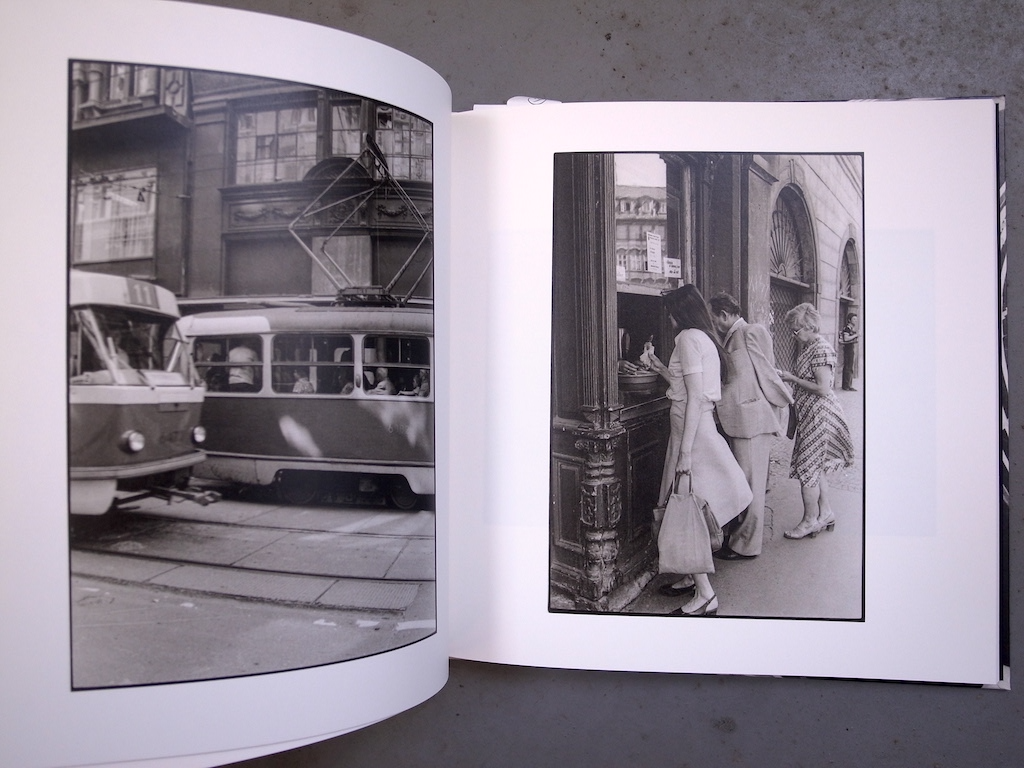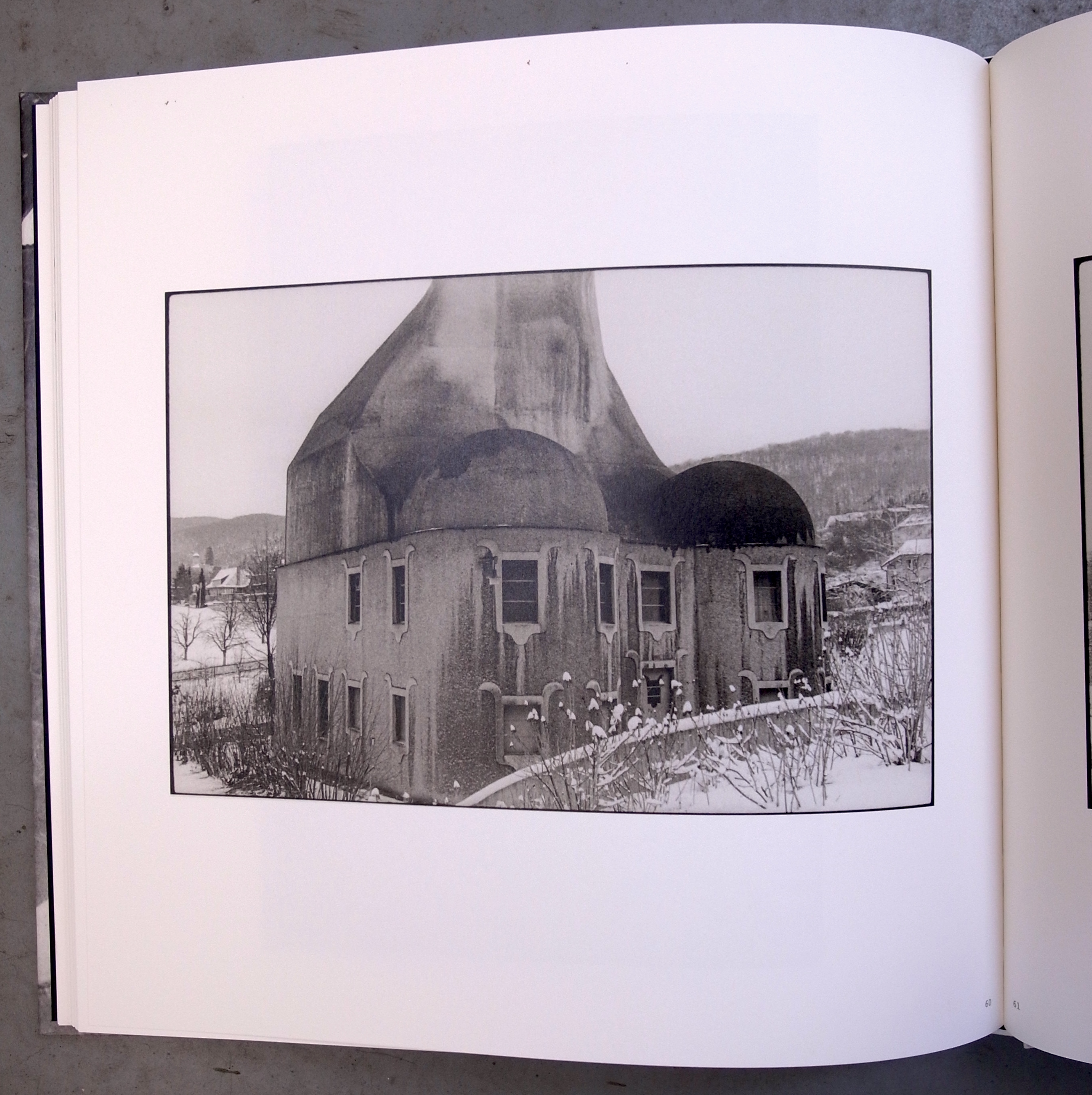コラム
落合憲弘
John Sypal
タカザワケンジ
なぎら健壱

I cannot can claim any kind of authority in setting the context for the subject of this book.
In fact, after my first look through, I Googled “German Expressionism” because at that point, my entire understanding of it was from the photos seen in this book- a visual thread of interest which Kazuo Kitai traced with his camera in Europe over forty years ago.
Wikipedia succinctly explains Expressionist Architecture as:
…an architectural movement in Europe during the first decades of the 20th century in parallel with the expressionist visual and performing arts that especially developed and dominated in Germany. Brick Expressionism is a special variant of this movement in western and northern Germany, as well as in the Netherlands (where it is known as the Amsterdam School). (Wikipedia:Expressionist architecture)
I see. My knowledge of this movement expanded to encompass Kitai’s monochromatic photos and a Wikipedia page or two. What stands out most here to me is “Brick Expressionism”. The bricks in the pages of Kitai’s book are indeed expressive.
How so? Well, No.6 on the list of “Characteristics” on the Expressionist Architecture Wikipedia page is:
6. Themes of natural romantic phenomena, such as caves, mountains, lightning, crystal and rock formations. As such it is more mineral and elemental than florid and organic which characterized its close contemporary Art Nouveau.
Natural Romantic Phenomena sounds fascinating but I’m getting ahead of myself.
In the book’s postscript, Kazuo Kitai, who had completed a series about rural farm villages in the hinterlands of Japan, writes that he was encouraged by Etsuro Ishihara (founder of Zeit Foto Salon) to now try something completely different: German Expressionist Architecture.
So, in 1979, Kitai traveled to Germany and over two trips (four months total) walked through of Europe with his Leica looking for Expressionist buildings on a journey that took him through Cologne, Hamburg, East and West Berlin, Amsterdam, Prague, Dornach, Poznan, and Bresula.
People who know more about German Expressionist Architecture (or residents of the aforementioned cities) will probably recognize many of the structures seen in these pages. I didn’t- but each looked charming. Where was each? Well, this book is no guidebook or report. Indeed, there is not a single caption or location given for any image. This is a fine idea. I think the removal of identifying labels or locations or architect names is, especially for the architecturally ignorant like me, a way to heighten the essence of the picture/place itself. (It’s also a bit like traveling- points of interest are often mute in meaning as you pass by.)
It was only after visiting Wikipedia that I learned that the charmingly Ghibli-like tower seen in a few pages is the Einstein Tower, a century-old observatory in Postdam. That’s quite a name to have on a building- before I read it my feelings for the place was one of curiosity and, strangely enough, comfort. I think that comfort (curiosity?) came from its curves- echoes of that “natural romantic phenomena” Wikipedia was talking about.
This brings me back to the expressive bricks.
I haven’t talked to Kitai san about this book yet, but I suspect that after his time in Japanese villages comprised of centuries-old wooden farmhouses with thatched-rooves and modular, paper-grid walls, the curves and details of German Expressionist structures would have had quite an impact. This isn’t to say this Tokyo-based photographer hadn’t seen bricks and concrete before- but that, as a photographer, such subject matter might seem to pose new challenges.
Let’s go back to Wikipedia. Entry number one on the List of Characteristics of Expressionism is “Distortion of form for an emotional effect.”.
Ah ha! See, Kitai’s work has never been about distortion. Rather than try to wring expression out of a subject with a lens, Kitai has always entrusted the result of his work to the straightforward nature of photography itself. It is precisely this contrast between this dynamic artistic movement and Kazuo Kitai’s innate sense of clarity that makes this book special.
Along with his kind, boyish character and bright smile, one of the truly wonderful things about Kazuo Kitai is how sure and equal he has always been with his camera. Regardless of location, the scope of his vision has always had a fair, open clarity to it. No matter what stands before his Leica, he frames it straightly, and kindly. In this book it encompasses a plethora of curvaceous elements- the spiral staircases, countless arches to the circular pyramid that is Wroclaw’s Centennial Hall- and the daily lives of the citizens who live among them. In fact, much of the book features Kitai’s street snaps of Europeans at the end of the 70s. They are photographed with the sense and distance (often physical & emotional) of a polite, friendly traveler. I have a feeling that Germans 50 and older may experience a particular sentimental pull to these pictures.
Related: Currently at Mono Graphy in Tokyo has a nice exhibition up of Kazuo Kitai's color work from his series "Color - Somehow Familiar Places". Copies of that book and "Journey into German Expressionism", along with original prints, are available in the gallery

私は最初この『ドイツ表現派紀行』という写真集に目を通した後、ドイツ表現主義についてGoogleで検索してみました。そもそも「表現主義」とは何か、この本に掲載されている写真から得たもの以上に語れるものがなかったのです。
ウィキペディアには「表現主義(建築)」について、以下のように書かれていました。
Wikipedia「表現主義 (建築)」
- …20世紀初頭にヨーロッパで見られた建築様式である。多分野にわたる表現主義運動の一環として、1910年頃のドイツ語圏や北欧で始まった。同時期のオランダにもアムステルダム派(英語版)(Amsterdamse School)の運動があった。初期のモダニズム建築が採用した材料の革新や社会の大衆化にともなう斬新なデザインに特徴がある。レンガや鉄、ガラスなどの大量生産によってもたらされた新たな技術的可能性にも着想を得ている。これらは映画などの視覚芸術におけるドイツ表現主義運動と並行して展開された。
ウィキペディアを参照したことで、表現主義というムーブメントに対する理解が少し拡がった気がします。私が最も注目したのはレンガでした。北井さんが写し出しているレンガは確かに表現的だと感じたからです。英語版ウィキペディアのExpressionist architecture(表現主義建築)ページの「特徴」6項目には、このように書いてありました(日本語版には記載なし)。
- 6. 洞窟、山、稲妻、水晶、岩の造形など、自然ロマンチックな現象をテーマとする。そのため、同時代のアール・ヌーボーを特徴づける華麗で有機的というよりは、鉱物的で元素的。
この本のあとがきで、日本の奥地の農村を撮影したシリーズ〈村へ〉を完結させた北井一夫さんは、ツァイト・フォト・サロン創設者の石原悦郎さんから、これまでとはまったく違うけどドイツ表現主義建築を撮ったらどうだろうかと勧められたと書いています。

1979年、北井さんはドイツへ渡り、ケルン、ハンブルク、東西ベルリン、アムステルダム、プラハ、ドルナハ、ポズナン、ブレスラなど、計4か月間、2度にわたる旅で、ライカを携えてドイツ表現主義建築を探し歩きました。

ドイツ表現主義建築に詳しい人(あるいは前述の都市の住民)なら、このページで紹介されている建築物の多くに見覚えがあるのでしょう。私はこの本を見るまで知りませんでしたが、それぞれが魅力的に見えます。
それぞれの建築はどの場所にあったのか、この本はガイドブックでもレポートでもありません。どの写真にもキャプションや場所は書かれていません。これはいいアイデアだ、と思いました。特に私のような建築に無知な者にとっては、ラベルや場所、建築家の名前が書かれていないことによって、写真や場所そのものの本質をより際立って見えるのです(なんとなく、旅に似ているような気がします。興味のあるポイントを通り過ぎるとき、その意味がわからなくなることがよくあるのです)。

この本のいくつかのページに載っている、ジブリ映画に出てくるような魅力的な塔は、ポズナニにある100年の歴史を持つ天文台で「アインシュタイン・タワー」であることがわかりました。場所についてや表現主義についての知識を得る前のこの場所に対する感情は、好奇心と、不思議な心地良さでした。その心地良さはウィキペディアにも書かれていた「自然のロマンチックな現象」の反響からきているのかもしれません。
ここで、私が着目した「レンガ」の話に戻りましょう。
この写真集について北井さんとはまだ話をしていないのですが、築数百年の、藁葺き屋根や格子壁の木造農家が密集する日本の村々を旅してきた北井さんにとって、ドイツ表現主義建築の曲線やディテールはかなりのインパクトがあったのではないだろうかと想像します。東京近辺を拠点とする北井さんが、それまでレンガやコンクリート造りの建築を見たことがなかったというわけではないのでしょうが、写真家として、このような被写体は新たな挑戦だったのかもしれません。

表現主義建築の「特徴」リストの1項目は「感情的な効果を目的とした形の歪曲」です。
北井さんの作品は決して歪曲が目的ではありません。被写体から表情を引き出そうとするのではなく、北井さんは常に写真そのものの素直な性質に作品の結果を委ねてきました。このダイナミックな芸術運動と北井一夫という写真家の生来の明晰さとの対比こそが、この写真集を特別なものにしているのです。

北井一夫さんの本当に素晴らしいところのひとつは、少年のような優しい性格と明るい笑顔とともに、彼がカメラを向ける被写体に対して常に平等であることです。場所を問わず、彼の視野は常に公平で開放的な明瞭さをもっています。ライカの前に何が立ちはだかっても、彼はそれをまっすぐに、そして親切にフレーミングします。
この写真集では、螺旋階段、無数のアーチ、ヴロツワフの百周年記念ホールである円形のピラミッドなど、曲線的な要素の数々、そしてその中で暮らす市民の日常が収められています。実際、この本の大部分を占めるのは、北井さんが1970年代末のヨーロッパの人々を撮影したストリートスナップです。 彼らは、礼儀正しくフレンドリーな旅行者の感覚と距離感(しばしば物理的で感情的)で撮影されています。現在50歳以上のドイツ人なら、これらの写真に特別な感傷を覚えるのではないでしょうか。

最後に、現在、東京のMONO GRAPHY Camera & Artというギャラリーでは、北井一夫さんのシリーズ〈いつか見た風景〉〈フランス放浪〉からなる写真集『COLOR いつか見た風景』からの作品が展示がされています。展示作品も、オリジナルプリントが付く写真集『ドイツ表現派紀行』もギャラリーで販売されています。プリントも写真集も実際に見てみてほしいです、おすすめです!
- Kazuo Kitai "Journey into German Expressionism"
- Published by PCT
- 北井一夫 写真集『ドイツ表現派紀行』
- 発行:PCT
- 発行日:2023年4月20日
- 編集:村上仁一
- デザイン:石山さつき
- 翻訳:ロバート・ツェツシェ
- [通常版]4,400円(税込)
- https://photoandculturetokyo.stores.jp/items/642d1232dfdb47005f3a0533
- [限定版]16,500円(税込)
- https://photoandculturetokyo.stores.jp/items/642d14d69d5f2b0028f84c65


PCT Membersは、Photo & Culture, Tokyoのウェブ会員制度です。
ご登録いただくと、最新の記事更新情報・ニュースをメールマガジンでお届け、また会員限定の読者プレゼントなども実施します。
今後はさらにサービスの拡充をはかり、より魅力的でお得な内容をご提供していく予定です。
 「Photo & Culture, Tokyo」最新の更新情報や、ニュースなどをお届けメールマガジンのお届け
「Photo & Culture, Tokyo」最新の更新情報や、ニュースなどをお届けメールマガジンのお届け 書籍、写真グッズなど会員限定の読者プレゼントを実施会員限定プレゼント
書籍、写真グッズなど会員限定の読者プレゼントを実施会員限定プレゼント